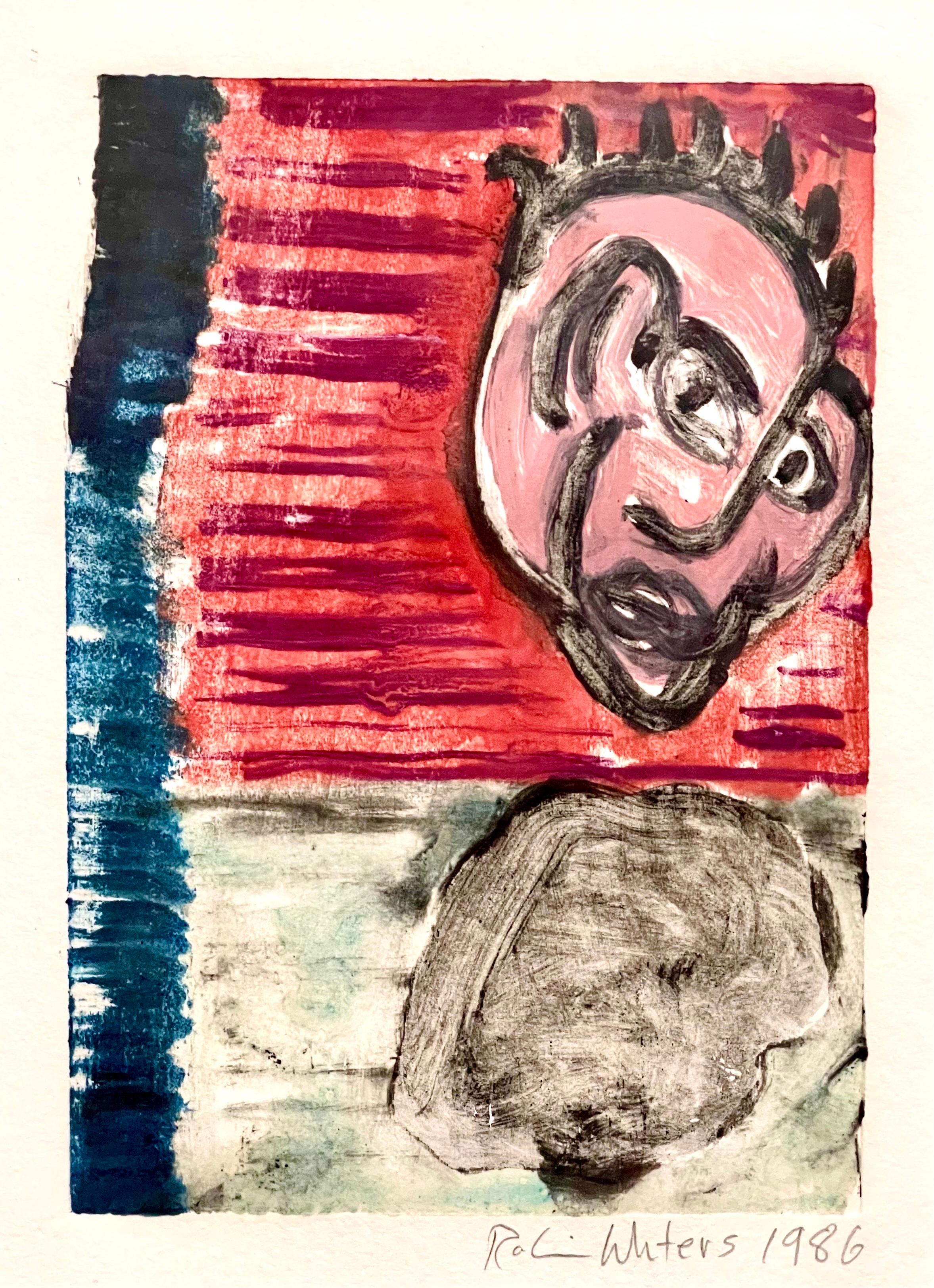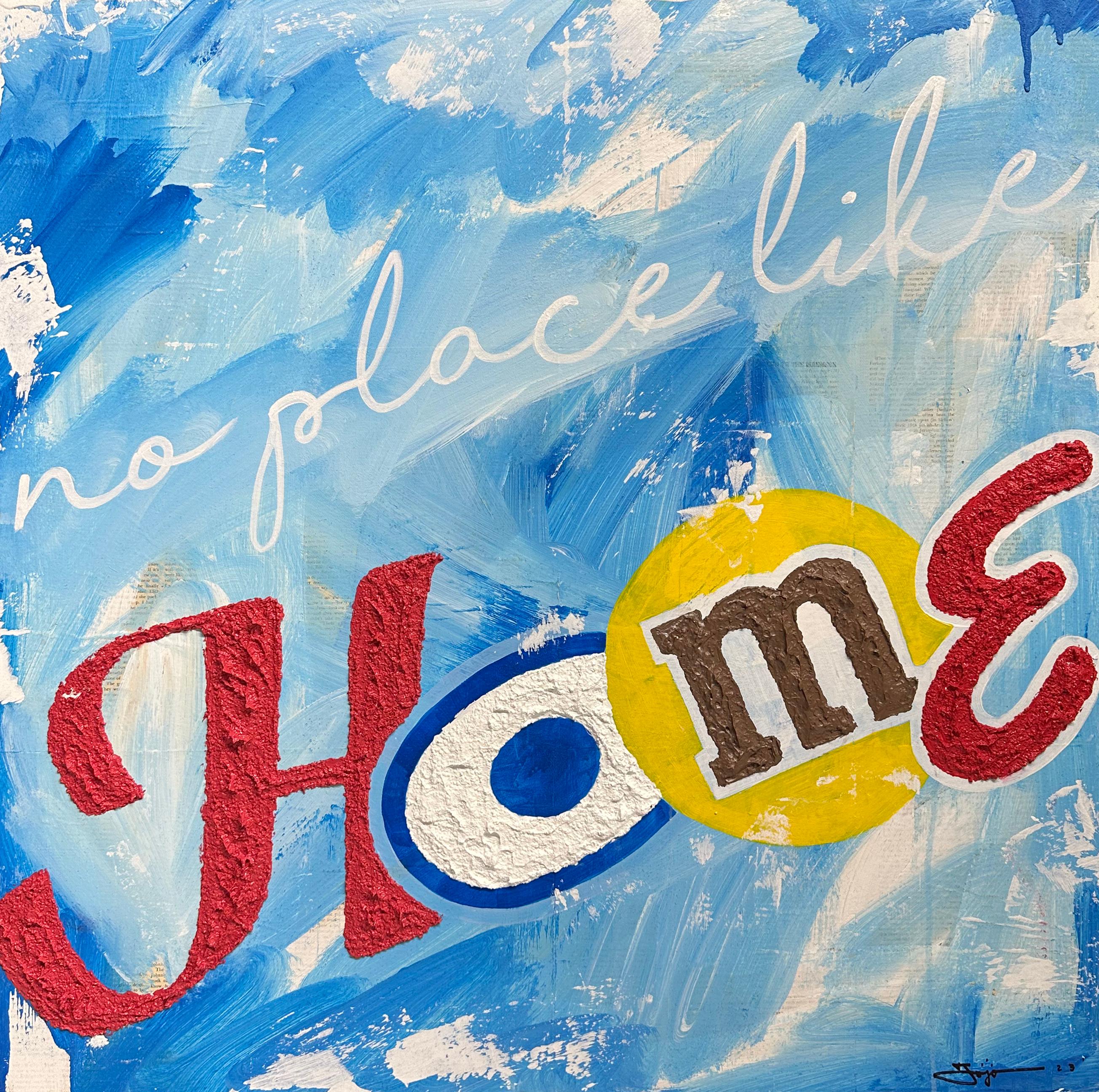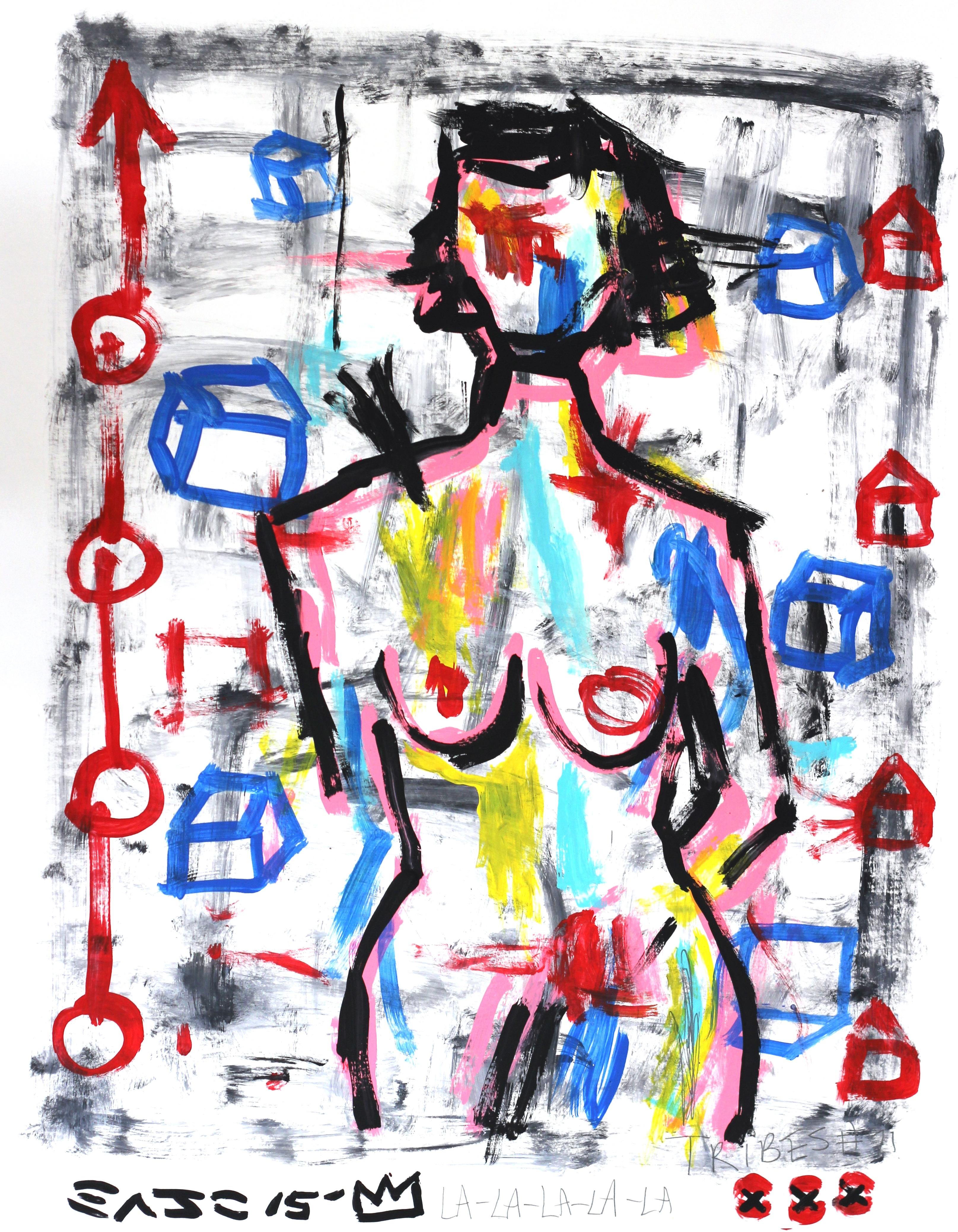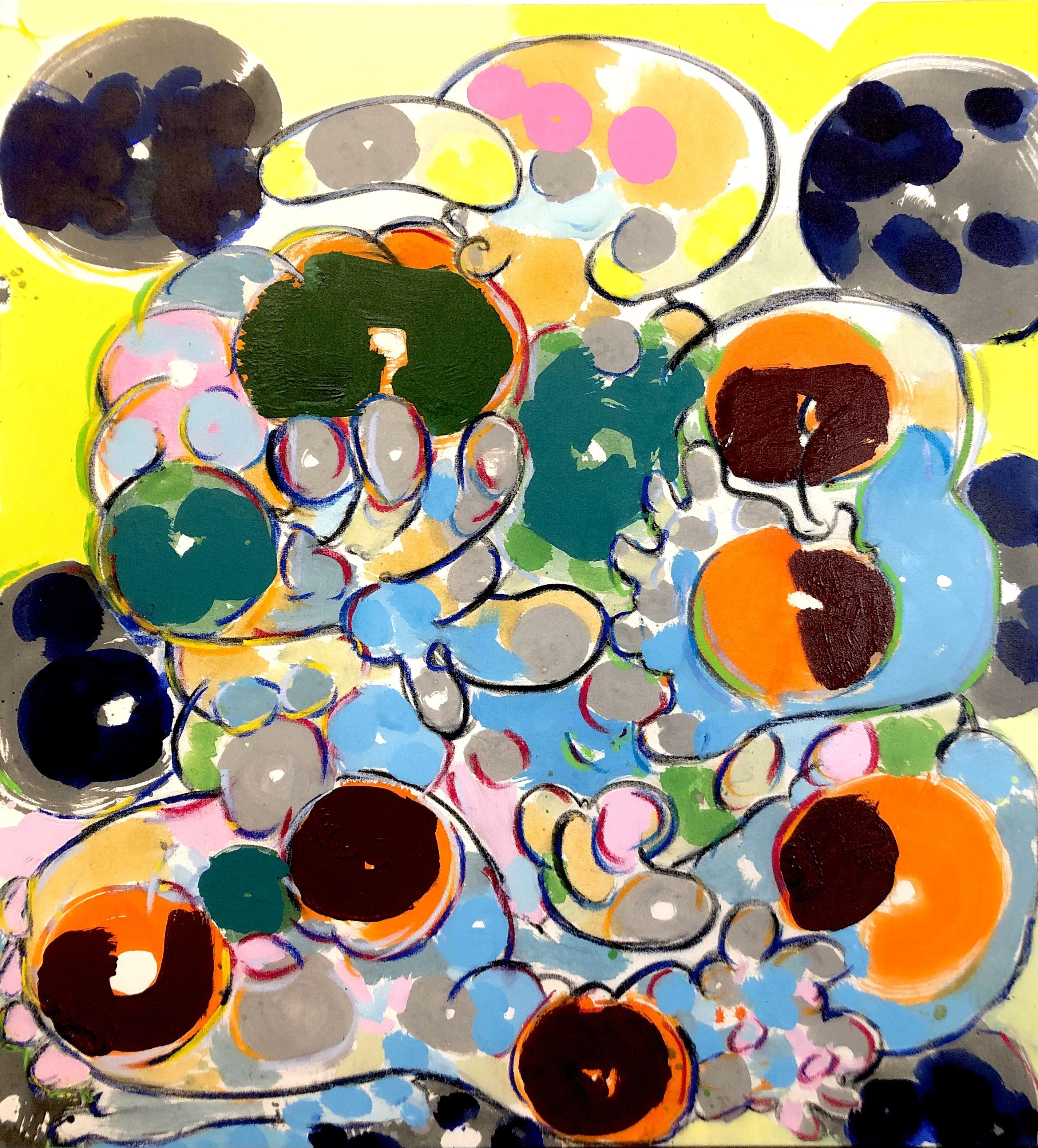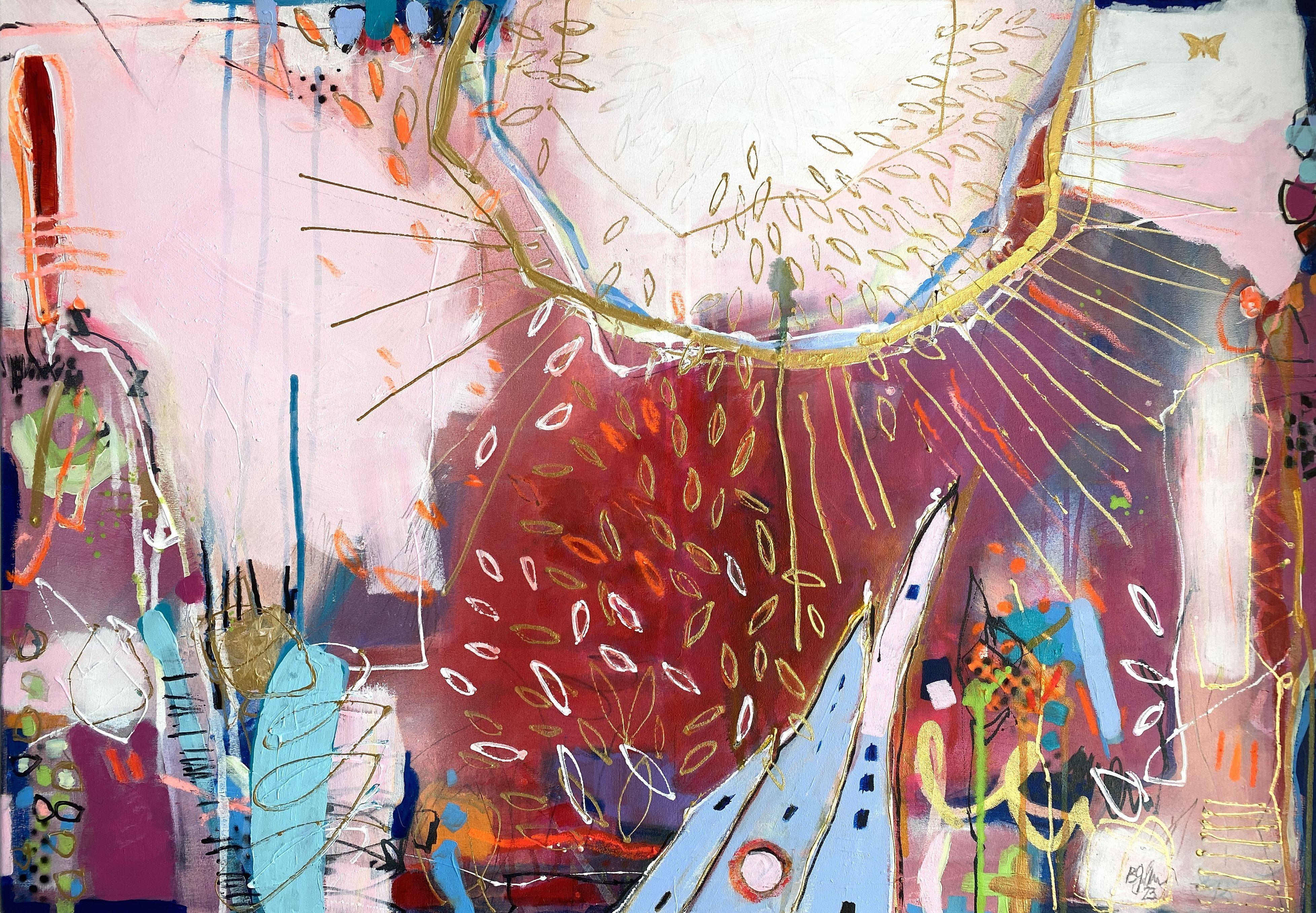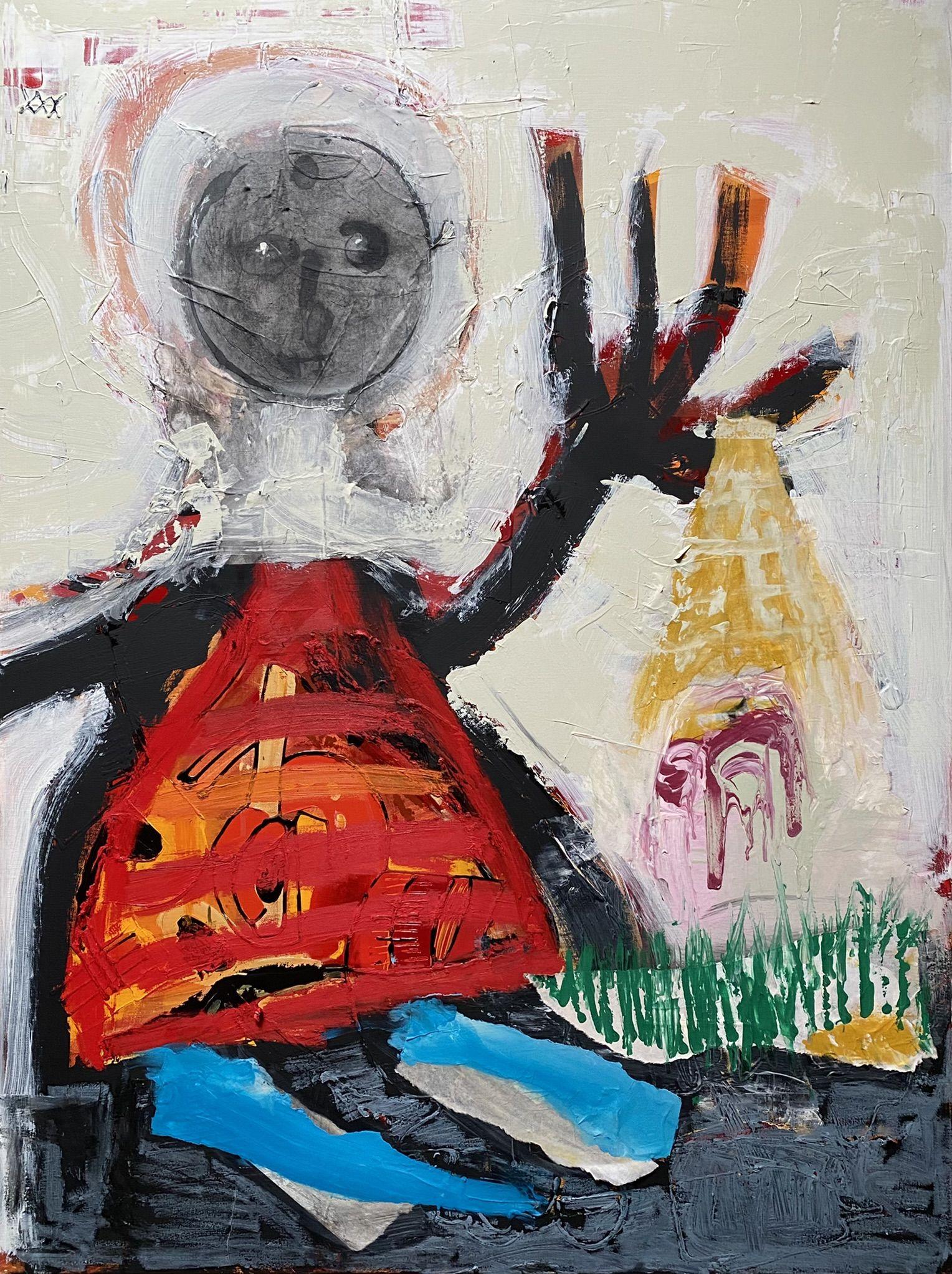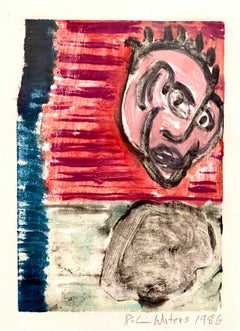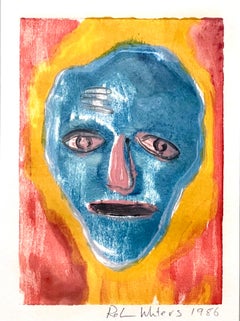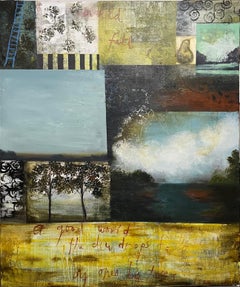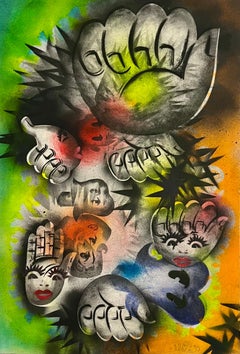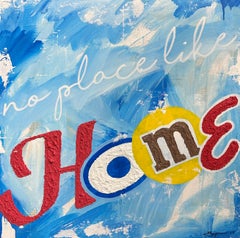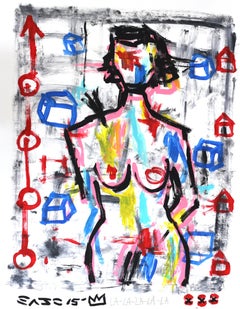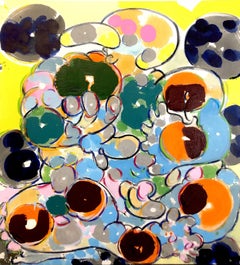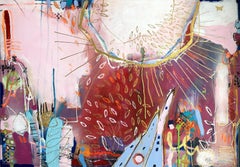Items Similar to Conceptual Pop Art Color Mixed Media Painting "Home" Brooke Alexander Gallery
Want more images or videos?
Request additional images or videos from the seller
1 of 16
Robin WintersConceptual Pop Art Color Mixed Media Painting "Home" Brooke Alexander Gallery1986
1986
$10,000
£7,595.25
€8,735.92
CA$13,971.96
A$15,580.32
CHF 8,129.15
MX$191,176.36
NOK 103,471.06
SEK 98,036.59
DKK 65,199.42
Shipping
Retrieving quote...The 1stDibs Promise:
Authenticity Guarantee,
Money-Back Guarantee,
24-Hour Cancellation
About the Item
Robin Winters (b. 1950) hand signed; 1986. Acrylic, rhoplex and powdered pigment on screenprint
Dimensions: 36”h, 32”w
Title: "Home"
Provenance: Brooke Alexander Gallery, New York, New York. Gallery label verso.
Robin Winters is known for his conceptual works in a wide variety of two- and three-dimensional media and performance/durational art. The reliquary and other recurring themes that appear in his works can be seen in the collection of sculptures and paintings offered in this sale (lots 170, 171, 173, 393, 396). Gallery label to reverse: Brooke Alexander Gallery, New York, New York. Provenance: Brooke Alexander Gallery, New York, New York.
Robin Winters (born 1950 in Benicia, California) is an American conceptual, multi-disciplinary, artist and teacher based in New York. Winters is known for creating solo exhibitions containing an interactive durational performance component to his installations, sometimes lasting up to two months. Winters first emerged in the burgeoning Soho NYC art scene of the 1970s. An early practitioner of the Relational Aesthetics (social interaction as an art medium) Winters also created in works through sculpture, installation, performance, painting, drawing and prints. His art maintains a whimsical spirit, and he often returns to ongoing themes involving faces, boats, cars, bottles, hats and jesters or fools. Winters has incorporated such devices as blind dates, double dates, dinners, fortune telling, and free consultation in his performances. Throughout his career he has engaged in a wide variety of media, such as performance art, film, video, writing prose and poetry, photography, installation art, printmaking, drawing, painting, ceramic sculpture, bronze sculpture, and glassblowing.
Winters was born in Benicia, California in 1950 to lawyer parents. As a child his hobby was collecting glass bottles found on the beach and under old buildings, which would later influence him as an artist. In 1968, Winters had his first durational performance, entitled Norman Thomas Travelling Museum. The artist drove a Volkswagen bus decorated in collage, many of the images relating to current events and politics. Inside was what the artist described as a “reliquary” containing many objects, including a bottle collection. Winters took the van to shopping centers and even as far as Mexico. That same year, Winters opted not to register for the military draft. Although he was deemed fit to serve, Winters refused. In 1975 the resulting legal proceedings finally came to a close after it was proven that the artist had been harassed by the local draft board. In his teens and early twenties, Winters became acquainted with several local artists who helped shape his aesthetic, most notably Manuel Neri and Robert Arneson. By the early 1970s, Winters was studying at the San Francisco Art Institute (SFAI) and had relocated to San Francisco. At this time Winters became friends with the Bay Area conceptual artists Terry Fox and Howard Fried, and participated in several of Fried's performance works. In 1972 Winters was accepted into the Whitney Independent Study Program in New York City. After coming to New York City, Winters helped support himself by working for various artists, among them the performance artist Joan Jonas and sculptor Donald Judd. In 1974, Winters performed The Secret Life of Bob-E or Bob-E Behind the Veil eight hours a day, five days a week for a month in his studio apartment. Behind a one-way mirror the audience could watch Winters play the character of Bob-E, whose goal was to make a monument for everyone in the world in the form of blue and yellow rubber top hats. By the end of the month the artist had constructed 262 hats. The following year, Winters was invited to take part in the Whitney Museum's 1975 Biennial Exhibition. Entitled W.B. Bearman Bags a Job or Diary of a Dreamer. These meetings led to the formation of the Group Collaborative Projects, or Colab, of which Winters is a founding member. Also in 1976, Winters formed the partnership “X&Y” with fellow artist Coleen Fitzgibbon that would last two years. Together they performed a series of shows in the Netherlands, most notably a show entitled Take the Money and Run. Performed at De Appel in Amsterdam, the show involved the artists robbing their audience. The following day the audience was given an apology, as well as the opportunity to retrieve any valuables and participate in a lottery to win the artists’ services. They also made a Super 8 film in NY called Rich-Poor, in which they asked people on the streets their thoughts on the rich and poor.
In 1980 Winters participated in The Real Estate Show and in Absurdities at ABC No Rio. That same year he and artists Peter Fend, Coleen Fitzgibbon, Peter Nadin, Jenny Holzer, and Richard Prince also formed The Offices of Fend, Fitzgibbon, Holzer, Nadin, Prince & Winters. This short-lived collective was based out of an office on lower Broadway and offered “Practical Esthetic Services Adaptable to Client Situation”, as stated on their business card. Their goal was to offer their art as “socially helpful work for hire”. In June of that year Winters participated in The Times Square Show, Colab's most well-known exhibition. The month-long show took place in a four floor building on West 41st Street and was densely packed with art. To cap off a busy year, Winters also became one of the first artists to join the Mary Boone Gallery, showing a successful solo exhibition in 1981. His work was shown in the New York/New Wave show in 1981 at MoMA PS1 along with Jean-Michel Basquiat, Roberta Bayley, William S. Burroughs, David Byrne, Sarah Charlesworth, Larry Clark, Crash (John Matos), Ronnie Cutrone, Brian Eno, Peter Fend, Nan Goldin, Keith Haring, Ray Johnson, Joseph Kosuth, Marcus Leatherdale, Christopher Makos, Robert Mapplethorpe, Elaine Mayes, Frank Moore, Kenny Scharf and others. In 1982, Winters had his first solo exhibition in Los Angeles at the Richard Kuhlenschmidt Gallery. At the Mo David Gallery in 1984, Winters created an installation piece that consisted of a floor of plaster tiles. Underneath each tile, hidden from view, was a drawing. He designed the stage sets for the musician Nico, and assisted French artist Orlan, American artist Stuart Sherman, and American poet Gregory Corso. Two years later Winters was invited to take part in Chambres d’Amis (In Ghent there is Always a Free Room for Albrecht Durer) in Ghent, Belgium. In it, 51 artists created installations in 50 different sites, mostly private homes. Winters chose the home of a local art historian. The artist made 90 drawings based on images found in the large collection of art books in the home's library. He made two copies of each drawing and placed the originals in the books themselves. One set of copies was exhibited in the sponsoring museum, Museum van Hedendaagse, as "The Ghent Drawings". The drawings were also on display at Winters’ solo exhibition at Luhring Augustine & Hodes Gallery in New York City in 1987.
In 1986, Winters had a solo exhibition at Maurice Keitelman Gallery in Brussels, Belgium, and the following year a solo exhibition at the Centre Régional d'Art Contemporain Midi-Pyrénées in Toulouse, France. Also in 1986, Winters' Playroom was held at the Institute for Contemporary Art in Boston, Massachusetts. The exhibition was part of Think Tank, a retrospective of Winters' work which traveled to the Stedelijk Museum in the Netherlands, the Centre Regional d’Art Contemporain in France, and the Contemporary Arts Center in Ohio. Winters spent a month in 1989 working with students at the San Francisco Art Institute. Never having worked with ceramics, he spent the month making numerous ceramic pieces, which were then shown in the aptly named One Month in San Francisco. Other components of the piece included Winters’ childhood bottle collection and a video showing each piece in the show filmed briefly next to a ruler.[ Also that year, Robin served as a visiting artist at the Pilchuck Glass School, where he met artist John Drury, who was then working as the school's artist liaison.
In the summer of 1990, Winters interviewed fellow artist Kiki Smith for her eponymous book, which was published later that year. That same year (1990), Winters was invited by the Val Saint Lambert glass factory in Belgium to create glassworks in their facility. Winters, artists John Drury and Tracy Glover traveled to Liege from the US, and the three in combination with two of the factories master glassblowers, realized Mr. Winters' work over six weeks time. A portion of the works, a group of glass heads and hats that the artist had produced at the factory, were exhibited in 1990 at the Centre d’Art Contemporain Geneve in Geneva, Switzerland. Later in the year they were included in his solo exhibition at Brooke Alexander Gallery in New York City. They were also shown at Facts and Rumours, an exhibition at the Witte de With Center for Contemporary Art in Rotterdam, the Netherlands in 1991. Winters had a solo exhibition at Van Esch Galerie in Eindhoven, the Netherlands called I am not Indifferent in 1991. The show consisted of paintings, glass heads, and bronze sculpture. Two years later he had another solo exhibition at the Renaissance Society at the University of Chicago, entitled Human Nature. Several hundred heads, made of glass and ceramic, lined the walls and were arranged in rings on the floor. Also on display were various paintings and bronzes. In 1994 Winters had a show at the Michael Klein Gallery in New York City entitled Notes from the Finishing Room, a solo exhibition of paintings. The artist also collaborated with fellow Benicia natives and glass artists Leroy Champagne and Michael Nourot to create pieces for Glass Roots, held in his hometown of Benicia, California at the Arts Benicia Center Gallery. In 1997 Winters participated in the exhibition Het Drinkglas, or The Drinking Glass, at Stichting Leerdam Glasmanifestatie in Leerdam, the Netherlands, and in 2000 he had a solo exhibition called Flowering at Brutto Gusto in Rotterdam, the Netherlands.
From 2001 to early 2003, Winters work was exhibited along with other contemporary artists in Heart of Glass. The show began at the Queens Museum of Art in New York City, and the next year traveled to the Crafts Council in London, England. In 2007, Winters had a solo exhibition at Brutto Gusto in Berlin, Germany. The show, entitled Please Forgive Me, I am an American, consisted of a selection of the artist's work from the previous twenty years. Interest in the legacy of Colab saw a resurgence beginning in 2011, and Winters’ work was included in the exhibition A Show About Colab (And Related Activities) held at Printed Matter in New York City. The show covered many of Colab's endeavors from the late seventies to the early eighties. The following year The Times Square Show Revisited was held in the Bertha and Karl Leubsdorf Art Gallery at Hunter College in New York City. Along with his work being included in the show, Winters took part in a panel discussion at the college. Also in 2012, Winters took part in It’s Always Summer on the Inside, an exhibition of paintings and large drawings held at the Anton Kern Gallery in New York City. In January 2013 Winters’ work was featured in the exhibition A Vase is a Vase is a Vase, held at Brutto Gusto in Berlin, Germany.
Awards
1978 New York State Council on the Arts Grant
1980 National Endowment for the Arts Grant
1985 Engelhard Foundation Grant
1991 New York Foundation for the Arts Grant
1998 John Simon Guggenheim Memorial Foundation Fellowship in Fine Arts
Collections
Aldrich Museum of Contemporary Art – Ridgefield, CT
Boymans-van Beuningen Museum – Rotterdam, the Netherlands
Brooklyn Museum of Art – New York, NY
Centraal Museum – Utrecht, the Netherlands
Groningen Museum – Groningen, the Netherlands
List Visual Arts Center, Massachusetts Institute of Technology – Cambridge, MA
MacArthur Foundation – Chicago, IL
Rijksmuseum Kröller-Müller – Otterlo, the Netherlands
Metropolitan Museum of Art – New York, NY
Museum of Modern Art – New York, NY
Museum Van Hedendaagse Kunst – Ghent, Belgium
The New Museum – New York, NY
Philadelphia Museum of Art – Philadelphia, PA
San Francisco Museum of Modern Art – San Francisco, CA
Smithsonian Museum – Washington, D.C.
“Sol Lewitt Collection”, Wadsworth Atheneum – Hartford, CT
Stedelijk Museum – Amsterdam, the Netherlands
The Arts Club – Chicago, IL
The Kitchen – New York, NY
University Art Museum – Berkeley, CA
Val Saint Lambert Crystal Fabric – Liege, Belgium
Whitney Museum of American Art – New York, NY
Williams College Museum of Art – Williamstown, MA
- Creator:Robin Winters (1950)
- Creation Year:1986
- Dimensions:Height: 36 in (91.44 cm)Width: 32 in (81.28 cm)
- Medium:
- Movement & Style:
- Period:
- Condition:good. light wear commensurate with age. please see photos.
- Gallery Location:Surfside, FL
- Reference Number:1stDibs: LU38214830872
About the Seller
4.9
Platinum Seller
Premium sellers with a 4.7+ rating and 24-hour response times
Established in 1995
1stDibs seller since 2014
1,782 sales on 1stDibs
Typical response time: <1 hour
- ShippingRetrieving quote...Shipping from: Surfside, FL
- Return Policy
Authenticity Guarantee
In the unlikely event there’s an issue with an item’s authenticity, contact us within 1 year for a full refund. DetailsMoney-Back Guarantee
If your item is not as described, is damaged in transit, or does not arrive, contact us within 7 days for a full refund. Details24-Hour Cancellation
You have a 24-hour grace period in which to reconsider your purchase, with no questions asked.Vetted Professional Sellers
Our world-class sellers must adhere to strict standards for service and quality, maintaining the integrity of our listings.Price-Match Guarantee
If you find that a seller listed the same item for a lower price elsewhere, we’ll match it.Trusted Global Delivery
Our best-in-class carrier network provides specialized shipping options worldwide, including custom delivery.More From This Seller
View AllConceptual Pop Art Color Oil Monotype Painting Abstract Figure Robin Winters
By Robin Winters
Located in Surfside, FL
Robin Winters (American, born 1950),
Untitled (Red Face) from "Cherry Block Series" 1986, monotype, pencil signed and dated lower right, plate: 6"h x 8.5"w, overall (with frame): 22.25"h x 18.25"w. Provenance: Property from a Private Collection, San Francisco.
Winters was invited to make monotypes at Experimental Workshop in San Francisco, (they printed Richard Bosman, Sam Francis, Claire Falkenstein, Deborah Oropallo and Kenneth Noland and many more greats). Winters chose to paint on wood blocks rather than the more usual metal plates in order to capture the organic quality of the natural material. He exploited a salient characteristic of the monoprint in Ghost Story by adding new painted elements onto the increasingly faint ghost images that result from successive impressions from a single block. In so doing he achieved the effect of transparent layers of color and shadow imagery. Winters's brightly-colored monotypes portray an array of figures and landscapes (and an occasional still-life) that, although can be seen in the context of a general trend away from abstraction that has marked the 1980s, defy strict stylistic categorization. They are neither realistic nor abstract, psychological self-examinations nor narrative fictions, but they contain elements of all of these approaches. Like Jonathan Borofsky, Winters derives much of his subject matter from dreams, believing that through his private fears and obsessions he can touch similar emotions in others. Although at first glance Winters's images look as if they could have been made by a child, closer attention reveals sly art historical references to Jackson Pollock and Pattern Painting (the drip and splatter backgrounds), Mark Rothko (the three-part horizontal compositions) and Minimalism (the gridded Cherry Block Series: Bread Beat).
Robin Winters (born 1950 in Benicia, California) is an American conceptual, multi-disciplinary, artist and teacher based in New York. Winters is known for creating solo exhibitions containing an interactive durational performance component to his installations, sometimes lasting up to two months. Winters first emerged in the burgeoning Soho NYC art scene of the 1970s. An early practitioner of the Relational Aesthetics (social interaction as an art medium) Winters also created in works through sculpture, installation, performance, painting, drawing and prints. His art maintains a whimsical spirit, and he often returns to ongoing themes involving faces, boats, cars, bottles, hats and jesters or fools. Winters has incorporated such devices as blind dates, double dates, dinners, fortune telling, and free consultation in his performances. Throughout his career he has engaged in a wide variety of media, such as performance art, film, video, writing prose and poetry, photography, installation art, printmaking, drawing, painting, ceramic sculpture, bronze sculpture, and glassblowing.
Winters was born in Benicia, California in 1950 to lawyer parents. As a child his hobby was collecting glass bottles found on the beach and under old buildings, which would later influence him as an artist. In 1968, Winters had his first durational performance, entitled Norman Thomas Travelling Museum. The artist drove a Volkswagen bus decorated in collage, many of the images relating to current events and politics. Inside was what the artist described as a “reliquary” containing many objects, including a bottle collection. Winters took the van to shopping centers and even as far as Mexico. That same year, Winters opted not to register for the military draft. Although he was deemed fit to serve, Winters refused. In 1975 the resulting legal proceedings finally came to a close after it was proven that the artist had been harassed by the local draft board. In his teens and early twenties, Winters became acquainted with several local artists who helped shape his aesthetic, most notably Manuel Neri and Robert Arneson. By the early 1970s, Winters was studying at the San Francisco Art Institute (SFAI) and had relocated to San Francisco. At this time Winters became friends with the Bay Area conceptual artists Terry Fox and Howard Fried, and participated in several of Fried's performance works. In 1972 Winters was accepted into the Whitney Independent Study Program in New York City. After coming to New York City, Winters helped support himself by working for various artists, among them the performance artist Joan Jonas and sculptor Donald Judd. In 1974, Winters performed The Secret Life of Bob-E or Bob-E Behind the Veil eight hours a day, five days a week for a month in his studio apartment. Behind a one-way mirror the audience could watch Winters play the character of Bob-E, whose goal was to make a monument for everyone in the world in the form of blue and yellow rubber top hats. By the end of the month the artist had constructed 262 hats. The following year, Winters was invited to take part in the Whitney Museum's 1975 Biennial Exhibition. Entitled W.B. Bearman Bags a Job or Diary of a Dreamer. Winters was traveling in 1975 and 1976, spending time in North Africa and in Europe. At a time when most young American artists were unaware of their European counterparts, Winters met and was influenced by such artists as Sigmar Polke and Marcel Broodthaers (with whom Winters worked on an installation) and also had a one-person exhibition, at the Konrad Fischer Gallery in Dusseldorf. Returning to New York in 1976, Winters teamed up with a group of artists to form Collaborative Projects (Colab), a rather anarchistic organization dedicated to artistic collaboration and the creation of art that questioned social values.. Also in 1976, Winters formed the partnership “X&Y” with fellow artist Coleen Fitzgibbon that would last two years. Together they performed a series of shows in the Netherlands, most notably a show entitled Take the Money and Run. Performed at De Appel in Amsterdam, the show involved the artists robbing their audience. The following day the audience was given an apology, as well as the opportunity to retrieve any valuables and participate in a lottery to win the artists’ services. They also made a Super 8 film in NY called Rich-Poor, in which they asked people on the streets their thoughts on the rich and poor.
In 1980 Winters participated in The Real Estate Show and in Absurdities at ABC No Rio. That same year he and artists Peter Fend, Coleen Fitzgibbon, Peter Nadin, Jenny Holzer, and Richard Prince also formed The Offices of Fend, Fitzgibbon, Holzer, Nadin, Prince & Winters. This short-lived collective was based out of an office on lower Broadway and offered “Practical Esthetic Services Adaptable to Client Situation”, as stated on their business card. Their goal was to offer their art as “socially helpful work for hire”. In June of that year Winters participated in The Times Square Show, Colab's most well-known exhibition. The month-long show took place in a four floor building on West 41st Street and was densely packed with art. To cap off a busy year, Winters also became one of the first artists to join the Mary Boone Gallery, showing a successful solo exhibition in 1981. His work was shown in the New York/New Wave show in 1981 at MoMA PS1 along with Jean-Michel Basquiat, Roberta Bayley, William S. Burroughs, David Byrne, Sarah Charlesworth, Larry Clark, Crash (John Matos), Ronnie Cutrone, Brian Eno, Peter Fend, Nan Goldin, Keith Haring, Ray Johnson, Joseph Kosuth, Marcus Leatherdale, Christopher Makos, Robert Mapplethorpe, Elaine Mayes, Frank Moore, Kenny Scharf and others. In 1982, Winters had his first solo exhibition in Los Angeles at the Richard Kuhlenschmidt Gallery. At the Mo David Gallery in 1984, Winters created an installation piece that consisted of a floor of plaster tiles. Underneath each tile, hidden from view, was a drawing. He designed the stage sets for the musician Nico, and assisted French artist Orlan, American artist Stuart Sherman, and American poet Gregory Corso. Two years later Winters was invited to take part in Chambres d’Amis (In Ghent there is Always a Free Room for Albrecht Durer) in Ghent, Belgium. In it, 51 artists created installations in 50 different sites, mostly private homes. Winters chose the home of a local art historian. The artist made 90 drawings based on images found in the large collection of art books in the home's library. He made two copies of each drawing and placed the originals in the books themselves. One set of copies was exhibited in the sponsoring museum, Museum van Hedendaagse, as "The Ghent Drawings". The drawings were also on display at Winters’ solo exhibition at Luhring Augustine & Hodes Gallery in New York City in 1987.
In 1986, Winters had a solo exhibition at Maurice Keitelman Gallery in Brussels, Belgium, and the following year a solo exhibition at the Centre Régional d'Art Contemporain Midi-Pyrénées in Toulouse, France. Also in 1986, Winters' Playroom was held at the Institute for Contemporary Art in Boston, Massachusetts. The exhibition was part of Think Tank, a retrospective of Winters' work which traveled to the Stedelijk Museum in the Netherlands, the Centre Regional d’Art Contemporain in France, and the Contemporary Arts Center in Ohio. Winters spent a month in 1989 working with students at the San Francisco Art Institute. Never having worked with ceramics, he spent the month making numerous ceramic pieces, which were then shown in the aptly named One Month in San Francisco. Other components of the piece included Winters’ childhood bottle collection and a video showing each piece in the show filmed briefly next to a ruler.[ Also that year, Robin served as a visiting artist at the Pilchuck Glass School, where he met artist John Drury, who was then working as the school's artist liaison.
In the summer of 1990, Winters interviewed fellow artist Kiki Smith for her eponymous book, which was published later that year. That same year (1990), Winters was invited by the Val Saint Lambert glass factory in Belgium to create glassworks in their facility. Winters, artists John Drury and Tracy Glover...
Category
1980s Pop Art Figurative Paintings
Materials
Monoprint, Monotype
Conceptual Pop Art Color Oil Monotype Painting Abstract Figure Robin Winters
By Robin Winters
Located in Surfside, FL
Robin Winters (American, born 1950),
Untitled (Red Face) from "Cherry Block Series" 1986, monotype, pencil signed and dated lower right, plate: 6"h x 8.5"w, overall (with frame): 22.25"h x 18.25"w. Provenance: Property from a Private Collection, San Francisco.
Winters was invited to make monotypes at Experimental Workshop in San Francisco, (they printed Richard Bosman, Sam Francis, Claire Falkenstein, Deborah Oropallo and Kenneth Noland and many more greats). Winters chose to paint on wood blocks rather than the more usual metal plates in order to capture the organic quality of the natural material. He exploited a salient characteristic of the monoprint in Ghost Story by adding new painted elements onto the increasingly faint ghost images that result from successive impressions from a single block. In so doing he achieved the effect of transparent layers of color and shadow imagery. Winters's brightly-colored monotypes portray an array of figures and landscapes (and an occasional still-life) that, although can be seen in the context of a general trend away from abstraction that has marked the 1980s, defy strict stylistic categorization. They are neither realistic nor abstract, psychological self-examinations nor narrative fictions, but they contain elements of all of these approaches. Like Jonathan Borofsky, Winters derives much of his subject matter from dreams, believing that through his private fears and obsessions he can touch similar emotions in others. Although at first glance Winters's images look as if they could have been made by a child, closer attention reveals sly art historical references to Jackson Pollock and Pattern Painting (the drip and splatter backgrounds), Mark Rothko (the three-part horizontal compositions) and Minimalism (the gridded Cherry Block Series: Bread Beat).
Robin Winters (born 1950 in Benicia, California) is an American conceptual, multi-disciplinary, artist and teacher based in New York. Winters is known for creating solo exhibitions containing an interactive durational performance component to his installations, sometimes lasting up to two months. Winters first emerged in the burgeoning Soho NYC art scene of the 1970s. An early practitioner of the Relational Aesthetics (social interaction as an art medium) Winters also created in works through sculpture, installation, performance, painting, drawing and prints. His art maintains a whimsical spirit, and he often returns to ongoing themes involving faces, boats, cars, bottles, hats and jesters or fools. Winters has incorporated such devices as blind dates, double dates, dinners, fortune telling, and free consultation in his performances. Throughout his career he has engaged in a wide variety of media, such as performance art, film, video, writing prose and poetry, photography, installation art, printmaking, drawing, painting, ceramic sculpture, bronze sculpture, and glassblowing.
Winters was born in Benicia, California in 1950 to lawyer parents. As a child his hobby was collecting glass bottles found on the beach and under old buildings, which would later influence him as an artist. In 1968, Winters had his first durational performance, entitled Norman Thomas Travelling Museum. The artist drove a Volkswagen bus decorated in collage, many of the images relating to current events and politics. Inside was what the artist described as a “reliquary” containing many objects, including a bottle collection. Winters took the van to shopping centers and even as far as Mexico. That same year, Winters opted not to register for the military draft. Although he was deemed fit to serve, Winters refused. In 1975 the resulting legal proceedings finally came to a close after it was proven that the artist had been harassed by the local draft board. In his teens and early twenties, Winters became acquainted with several local artists who helped shape his aesthetic, most notably Manuel Neri and Robert Arneson. By the early 1970s, Winters was studying at the San Francisco Art Institute (SFAI) and had relocated to San Francisco. At this time Winters became friends with the Bay Area conceptual artists Terry Fox and Howard Fried, and participated in several of Fried's performance works. In 1972 Winters was accepted into the Whitney Independent Study Program in New York City. After coming to New York City, Winters helped support himself by working for various artists, among them the performance artist Joan Jonas and sculptor Donald Judd. In 1974, Winters performed The Secret Life of Bob-E or Bob-E Behind the Veil eight hours a day, five days a week for a month in his studio apartment. Behind a one-way mirror the audience could watch Winters play the character of Bob-E, whose goal was to make a monument for everyone in the world in the form of blue and yellow rubber top hats. By the end of the month the artist had constructed 262 hats. The following year, Winters was invited to take part in the Whitney Museum's 1975 Biennial Exhibition. Entitled W.B. Bearman Bags a Job or Diary of a Dreamer. Winters was traveling in 1975 and 1976, spending time in North Africa and in Europe. At a time when most young American artists were unaware of their European counterparts, Winters met and was influenced by such artists as Sigmar Polke and Marcel Broodthaers (with whom Winters worked on an installation) and also had a one-person exhibition, at the Konrad Fischer Gallery in Dusseldorf. Returning to New York in 1976, Winters teamed up with a group of artists to form Collaborative Projects (Colab), a rather anarchistic organization dedicated to artistic collaboration and the creation of art that questioned social values.. Also in 1976, Winters formed the partnership “X&Y” with fellow artist Coleen Fitzgibbon that would last two years. Together they performed a series of shows in the Netherlands, most notably a show entitled Take the Money and Run. Performed at De Appel in Amsterdam, the show involved the artists robbing their audience. The following day the audience was given an apology, as well as the opportunity to retrieve any valuables and participate in a lottery to win the artists’ services. They also made a Super 8 film in NY called Rich-Poor, in which they asked people on the streets their thoughts on the rich and poor.
In 1980 Winters participated in The Real Estate Show and in Absurdities at ABC No Rio. That same year he and artists Peter Fend, Coleen Fitzgibbon, Peter Nadin, Jenny Holzer, and Richard Prince also formed The Offices of Fend, Fitzgibbon, Holzer, Nadin, Prince & Winters. This short-lived collective was based out of an office on lower Broadway and offered “Practical Esthetic Services Adaptable to Client Situation”, as stated on their business card. Their goal was to offer their art as “socially helpful work for hire”. In June of that year Winters participated in The Times Square Show, Colab's most well-known exhibition. The month-long show took place in a four floor building on West 41st Street and was densely packed with art. To cap off a busy year, Winters also became one of the first artists to join the Mary Boone Gallery, showing a successful solo exhibition in 1981. His work was shown in the New York/New Wave show in 1981 at MoMA PS1 along with Jean-Michel Basquiat, Roberta Bayley, William S. Burroughs, David Byrne, Sarah Charlesworth, Larry Clark, Crash (John Matos), Ronnie Cutrone, Brian Eno, Peter Fend, Nan Goldin, Keith Haring, Ray Johnson, Joseph Kosuth, Marcus Leatherdale, Christopher Makos, Robert Mapplethorpe, Elaine Mayes, Frank Moore, Kenny Scharf and others. In 1982, Winters had his first solo exhibition in Los Angeles at the Richard Kuhlenschmidt Gallery. At the Mo David Gallery in 1984, Winters created an installation piece that consisted of a floor of plaster tiles. Underneath each tile, hidden from view, was a drawing. He designed the stage sets for the musician Nico, and assisted French artist Orlan, American artist Stuart Sherman, and American poet Gregory Corso. Two years later Winters was invited to take part in Chambres d’Amis (In Ghent there is Always a Free Room for Albrecht Durer) in Ghent, Belgium. In it, 51 artists created installations in 50 different sites, mostly private homes. Winters chose the home of a local art historian. The artist made 90 drawings based on images found in the large collection of art books in the home's library. He made two copies of each drawing and placed the originals in the books themselves. One set of copies was exhibited in the sponsoring museum, Museum van Hedendaagse, as "The Ghent Drawings". The drawings were also on display at Winters’ solo exhibition at Luhring Augustine & Hodes Gallery in New York City in 1987.
In 1986, Winters had a solo exhibition at Maurice Keitelman Gallery in Brussels, Belgium, and the following year a solo exhibition at the Centre Régional d'Art Contemporain Midi-Pyrénées in Toulouse, France. Also in 1986, Winters' Playroom was held at the Institute for Contemporary Art in Boston, Massachusetts. The exhibition was part of Think Tank, a retrospective of Winters' work which traveled to the Stedelijk Museum in the Netherlands, the Centre Regional d’Art Contemporain in France, and the Contemporary Arts Center in Ohio. Winters spent a month in 1989 working with students at the San Francisco Art Institute. Never having worked with ceramics, he spent the month making numerous ceramic pieces, which were then shown in the aptly named One Month in San Francisco. Other components of the piece included Winters’ childhood bottle collection and a video showing each piece in the show filmed briefly next to a ruler.[ Also that year, Robin served as a visiting artist at the Pilchuck Glass School, where he met artist John Drury, who was then working as the school's artist liaison.
In the summer of 1990, Winters interviewed fellow artist Kiki Smith for her eponymous book, which was published later that year. That same year (1990), Winters was invited by the Val Saint Lambert glass factory in Belgium to create glassworks in their facility. Winters, artists John Drury and Tracy Glover...
Category
1980s Pop Art Figurative Paintings
Materials
Monoprint, Monotype
Abstract Mixed Media Painting African American Woman Artist Cheryl Warrick
Located in Surfside, FL
Cheryl Warrick (American, b. 1956),
"By Ones By Twos"
Acrylic mixed media on panel, 1999,
Hand signed in pencil, titled and dated verso, gallery label...
Category
1990s Contemporary Abstract Paintings
Materials
Mixed Media, Acrylic, Canvas
Surrealist Spray Paint Painting Mixed Media Rosie Palm Mason Rader Pop Art
Located in Surfside, FL
"Rosie Palm" 1995 by Mason Rader
A graduate of the L. Jeffrey Selznick School of Film Preservation at the George Eastman House in Rochester NY with a Bach...
Category
1990s Pop Art Abstract Paintings
Materials
Mixed Media, Spray Paint
Her Grandson, Mixed Media Painting Collage Wall Construction FIgural Abstraction
By Francie Bishop Good
Located in Surfside, FL
"Lady Looking at Brian (Her Grandson)" Mixed media collage, assemblage, gestural painting on masonite. Hand Signed in ink and titled verso. It does not appear to be dated. I am estimating it is from the 1980's. It has some Postmodern elements and similarities to Transavanguardia is the Italian version of Neo-expressionism.
Francie Bishop Good (American, 1949-)
Francie Bishop Good was raised in Allentown, Pennsylvania. She currently lives and works in South Florida and New York City. Her work has been exhibited nationally and internationally. Bishop Good is twice recipient of the South Florida Cultural Consortium Fellowship, and the State of Florida Individual Artist Fellowship. She completed her Graduate Studies at Maine Media College, Rockport, Maine, International Center of Photography, New York, New York, Master of Arts, Florida Atlantic University, Boca Raton, Florida, B.F.A. University of Colorado, Boulder, Colorado, Philadelphia College of Art, Philadelphia, Pennsylvania, William Allen High School, studies under James Musselman
Her museum solo shows include the Allentown Art Museum, Allentown, PA, Museum of Art, Fort Lauderdale, FL, the Museum of Contemporary Art, Jacksonville, FL, Art and Culture Center, Hollywood, FL, and the Hilliard Museum, Lafayette, LA.
Bishop Good's work has been shown at David Castillo Gallery, Mindy Solomon Gallery, Miami, FL.
Griffin Museum of Photography, Bernice Steinbaum Gallery, and AMbrosino Gallery.
Recent museum acquisitions include Museum of Fine Arts, Boston, MA The Wadsworth Atheneum, Hartford, CT, The Patricia & Philip Frost Art Museum at Florida International University, Miami, FL, Bass Museum of Art, Miami Beach, FL and the NSU Art Museum, Fort Lauderdale, FL.
Selected Group and Invitational Exhibitions
NSU Art Museum, Remember to React: 60 Years of Collection, Fort Lauderdale, FL
Frost Art Museum, Connectivity: Selections from the Collection of the Frost Art Museum, Miami, FL
Dual Roles, curated by Laura Marsh, Art and Culture Center of Hollywood FL
David Castillo Gallery, gallery artists, in terms of collage, Miami Beach, FL
Multidisciplinary, curated by Dimensions Variable, Open Source Gallery, Brooklyn, NY
Cornell Museum, Artistically Speaking,
Boca Raton Museum of Art, FL. People and Places, Photographs from the Collection, summer 2015
Frost Museum, FIU Miami FL, 25 Inches, The Faces of the Permanent Collection
Locust Projects, Smash and Grab, November
Annie Wharton Fine Art, Los Angeles group show, summer
Museum of Art Fort Lauderdale ,The Art of Caring summer
Women to Women, collaboration with Samantha Salzinger, Bakehouse
Fredric Snitzer Gallery Boy oh Boy, Summer Show Miami
A.I.R. Gallery, The Man I Wish I Was, curator Kharis Kennedy
Photo Miami with Nina Arias, Miami, FL December
Alva Gallery, New London, Ct Being Good: Women's Moral Values
Art Basel with Ambrosino Gallery, Miami, FL
51st Venice Biennale, Italy Poles Apart / Poles Together, International Artists' Museum, White Box
Norton Museum of Art, West Palm Beach, FL, FOCUS ON: New Photography,
National Museum of Women in the Arts, FL Transitory Patterns
Museum of Contemporary Art, Miami, FL Optic Nerve
Selected Collections
Museum of Fine Arts, Boston, Ma.
Wadsworth Atheneum Museum of Art, Hartford, Ct.
Bass Museum of Art, Miami Beach, FL
Frost Museum of Art, Miami Florida
Norton Museum of Art, West Palm Beach, Florida
Museum of Contemporary Art, Jacksonville, Florida
Boca Raton Museum of Art, Boca Raton, Florida
Sagamore Hotel Collection, Miami Beach, Florida
Museum of Art, Fort Lauderdale, Florida
Refco Collection, Chicago, Illinois
Allentown Art Museum, Allentown, Pennsylvania
New World Symphony Residence, Miami, Florida
Art in Public Places, Broward County, Florida
Art and Culture Center of Hollywood, Florida
William Gates III (Bill Gates)
Monica and Richard Segal
Saks Fifth Avenue
Asides from being an exceptional artist she is also a passionate collector. Photographs by Cindy Sherman and the late Ana Mendieta, collages by Kara Walker, a watercolor by Louise Bourgeois, Cecily Brown, Tracey Emin, Teresita Fernandez, Carrie Mae Weems, Nan Goldin, Barbara Kruger, Catherine Opie, Lorna Simpson, Kiki Smith, Mickalene Thomas, and Kara Walker. are among 100 works by leading contemporary artists donated by philanthropists David Horvitz...
Category
1980s Post-Modern Abstract Paintings
Materials
Masonite, Paper, Mixed Media, Oil
Mixed Media Painting SIlkscreen, Glitter Metal Flake, Acrylic Paint Darren Goins
Located in Surfside, FL
Darren Goins, (American, b. 1993)
Acrylic paint and metal flake glitter with silkscreen on paper
Not signed on front. (presumably signed verso but has not been examined out of frame)
Overall: 30-1/4"h x 26-1/4"w
Paper Size: 26-1/2"h x 22-1/2"w
Darren Goins (American Post War and Contemporary art) was born in 1984 in North Carolina but now resides in Los Angeles, California. Goins is well known for his unique style and aesthetic, which involves the combination of digital technologies and traditional painting methods to create abstract paintings. Working with a wide range of media–printmaking, painting, drawing, sculpture, neon–Goins’ art manages to capture the anxiety of the digital Information Age in both color and form. Creating imagery with both computer software and the paintbrush, Darren Goins’ paintings utilize both traditional methods of abstraction as well as digital intervention.Goins graduated from UNC Charlotte with a BFA in Photography and Printmaking and a minor in Art History. Goins soon moved to New York, and later Los Angeles where he currently lives and works.
Goins’ style utilizes computer software, like Adobe Photoshop or Microsoft Paint, in order to etch the image onto an acrylic panel using a CNC carver. He then paints over the surface, which in turn becomes the backside of the painting as the reverse side of the clear panel faces the viewer. Goins in this manner appears to be tricking the eyes of the viewers with his work; portraying the pieces as a base relief in reverse as if the painting is somehow bubbling up from behind the acrylic panel.
Goins’ pieces also confront the audience with how one can engage with, and utilizes, technology in art. Through his embrace of technical chance and his flexible, manual process, something organic peeks through from, within these images. In Goins’ paintings we can see the ghost of humanity filtered through digital media, fluidly weaved in space. Using his camera phone, digital prints, silver gelatin prints and screen-print drawings from his computer, Microsoft Paint or Photoshop. He has been exhibited internationally, Goins has had solo exhibitions at Hezi Cohen Gallery in Tel Aviv, Israel, Whitcher Projects in Los Angeles, Martin Lawrence Galleries, La Jolla, California and Hap Gallery in Portland, Oregon among others. Goins has participated as an artist-in-residence at Socrates Sculpture...
Category
21st Century and Contemporary Contemporary Abstract Paintings
Materials
Glitter, Acrylic, Screen
You May Also Like
Jojo Anavim - No Place Like Home, Painting 2023
By Jojo Anavim
Located in Greenwich, CT
Blurring the line between mass consumerism and fine art, New York City based artist Jojo Anavim has established his body of work stemming from a background in graphic design and bran...
Category
2010s Abstract Paintings
Materials
Canvas, Acrylic
"Muse" Colorful Figurative Pop Art Original by Gary John
By Gary John
Located in Los Angeles, CA
Los Angeles street artist Gary John exploded onto the international art scene first during Art Basel Miami in 2013. John’s playfully bold work quickly gained attention and he was nam...
Category
21st Century and Contemporary Street Art Mixed Media
Materials
Mixed Media, Acrylic, Board
There is more than one I in a creature, Painting, Acrylic on Canvas
By Barbara Kuebel
Located in Yardley, PA
This work took me from several safe places to another, abstraction and figuration, identity and new definition of being. I payed with patterns rather than formation and also included...
Category
21st Century and Contemporary Pop Art Paintings
Materials
Acrylic
Home Is Paradise No.2, Painting, Acrylic on Canvas
By Bea Garding Schubert
Located in Yardley, PA
Home is Paradise No.2 is a 70 cm H x 100 cm W, 2 cm deep mixed media painting. „To live in a peaceful home is to experience paradise on earth.“ ( Shri Radhe Maa ) Home is confi...
Category
2010s Pop Art Paintings
Materials
Acrylic
Stories from the Golden Era 1, Mixed Media on Canvas
By Veronica Dragnef
Located in Yardley, PA
Stories from the Golden Era . Reminiscing childhood moments, the drama when you are dropping your ice-cream cone :: Mixed Media :: Contemporary :: This piece comes with an official c...
Category
2010s Contemporary Mixed Media
Materials
Mixed Media
Home Is Love No.4, Painting, Acrylic on Canvas
Located in Yardley, PA
Home is Love No.4 is 50cm/19.68 in H x 50cm/19.68 in W x 4cm/1.58 in deep. Home is confidence, trust, hope and love. What and where is home? Home is an inner feeling. A home plays...
Category
2010s Abstract Abstract Paintings
Materials
Acrylic
More Ways To Browse
Pop Art Nyc
French Military Art
1980s Pop Art
1970s Pop Art
Chicago Pop Art
Fine Art In Plaster
Original Painting Book Cover Art
Art Glass Room Screens
Alexander John
David Winter
Vintage Champagne Art
1975 Pop Art
Lawyer Art
Pop Art Ceramic
New England Winter
Michael West Paintings
Robert Maplethorpe Art
Lawyer Painting
